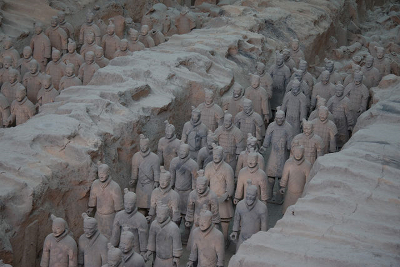Located in Xi'an, Shaanxi Province, China, the Museum of the Terracotta Warriors and Horses of Emperor Qin Shihuang is one of the world’s most famous archaeological sites. The stunning find consists of roughly 8,000 terracotta statues of ancient Chinese warriors arranged in battle formation. About 1,900 figures have been excavated so far. However, this is only a fraction of the total thought to exist underground. Each weighs 300-400 pounds and is more than 2,000 years old.
Terracotta horses, bronze chariots, and real weapons accompany the warriors. These include lances, arrowheads, and swords that had been painstakingly sharpened and never used. While the wooden parts have rotted away, archaeologists have found more than 40,000 arrowheads in the excavated pits.
 The soldiers, horses, and chariots are incredibly detailed and realistic. Scientists have determined that the statues are comprised of seven main parts that were molded separately and then pieced together. However, according to 3D scans and computer analysis, each warrior’s head appears to be unique. The sculptures also sport a variety of hairstyles and embellishments. Pigment found on the statues indicates that they were painted before being placed underground.
The soldiers, horses, and chariots are incredibly detailed and realistic. Scientists have determined that the statues are comprised of seven main parts that were molded separately and then pieced together. However, according to 3D scans and computer analysis, each warrior’s head appears to be unique. The sculptures also sport a variety of hairstyles and embellishments. Pigment found on the statues indicates that they were painted before being placed underground.
As with ancient Egypt, the Chinese of Qin’s time may have believed that the items used in life would also be needed after death. Some archaeologists theorize that Qin was preparing for battle against his enemies in the underworld.
Surprisingly, the terracotta warriors are not mentioned in Chinese histories. The subterranean army remained unknown to the world until a local farmer unearthed the statues in 1974. While the sculptures were broken after more than two millennia underground, archaeologists managed to fit the fragments back together.
The pits in which the warriors are buried are part of a 21-mile burial complex surrounding the Qinshihuang Mausoleum, the massive tomb of Emperor Qinshihuang himself. Qin conquered and unified the warring states of China to become its first emperor in 221 BCE. Work on his tomb began in 246 BCE. According to the historian Sima Qian (c. 145-95 BCE), Qin is buried at the centre of the mound, which contains a microcosm of the entire capital city, Xianyan. Qin’s burial mound itself will not be excavated until archaeologists are confident they can do so without damaging it. UNESCO designated the Qinshihuang Mausoleum a world heritage site in 1987.
Photo Credit: Maros Mraz, CC BY-SA 3.0